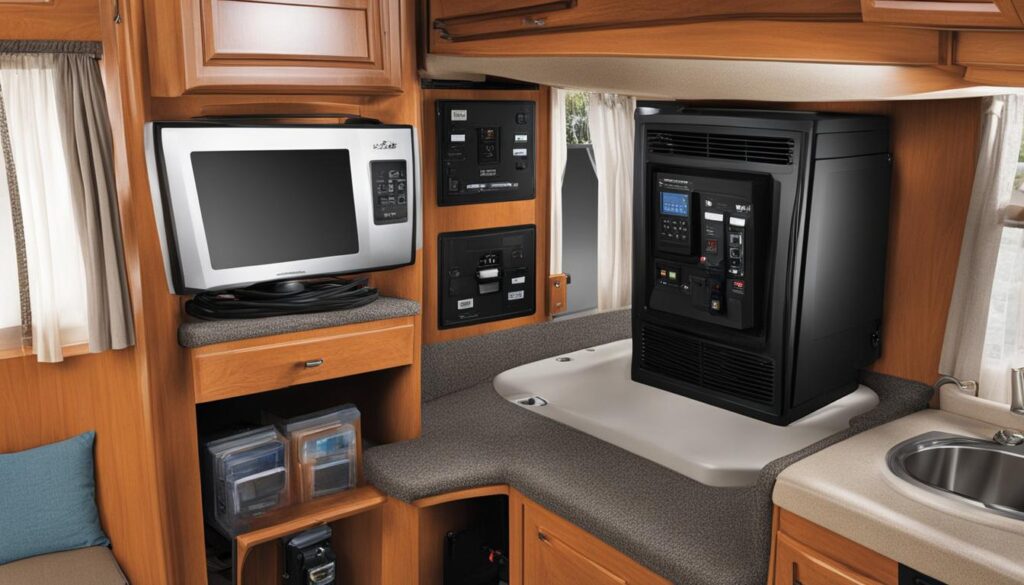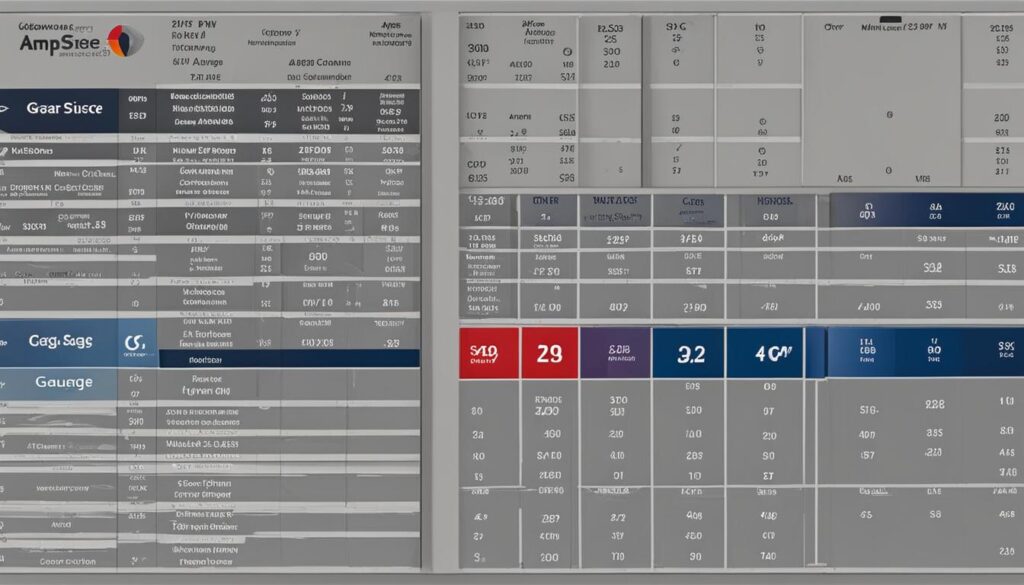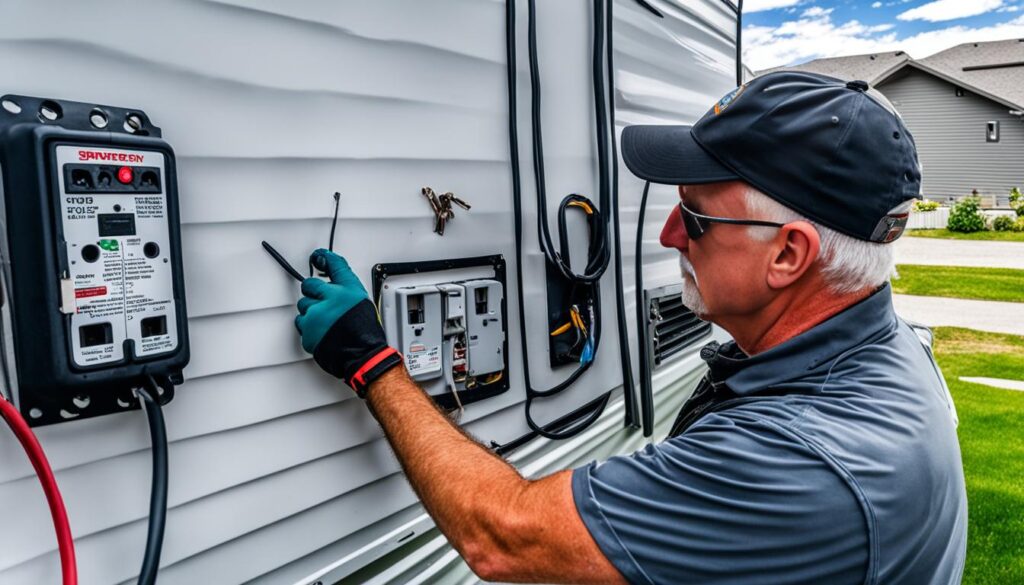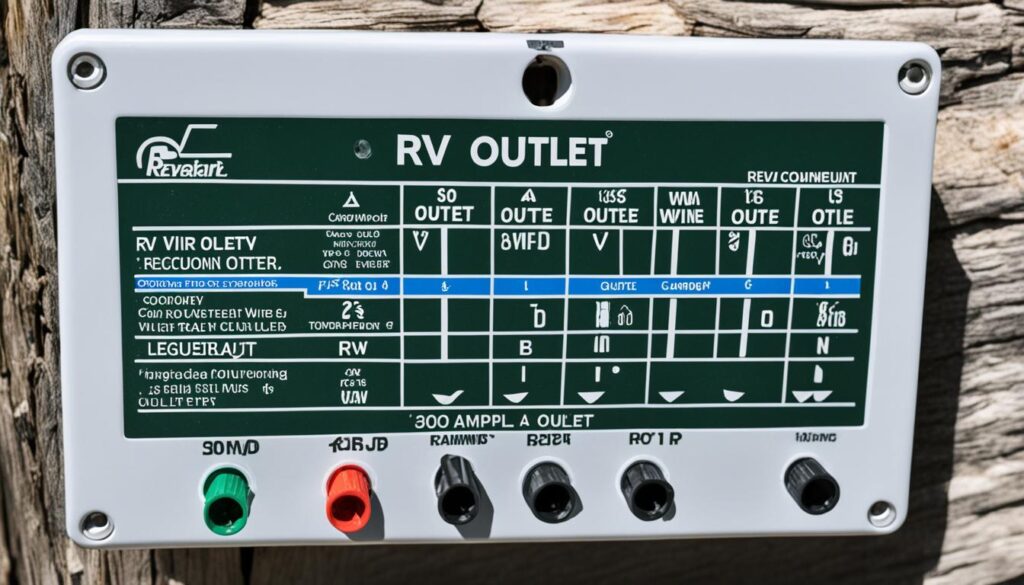Are you planning to install a 30 amp RV outlet but unsure about the wire size you need? Choosing the right wire gauge is crucial for the safe and efficient operation of your RV electrical system. Whether you’re a seasoned RV enthusiast or a newbie, understanding the correct wire size is essential to avoid potential hazards and ensure optimal performance.
In this comprehensive guide, I will walk you through everything you need to know about the wire size required for a 30 amp RV outlet. From the basics of a 30 amp RV electrical system to the installation process and important considerations, we’ll cover it all. Let’s get started on your journey to becoming an informed RV owner!
Key Takeaways:
- The recommended wire size for a 30 amp RV circuit is 10-gauge wire.
- Consult a licensed electrician for proper installation and to meet electrical code requirements.
- Consider voltage drop and temperature adjustments when determining wire size for longer distances.
- The wiring process involves turning off the power, running wires through conduit, and connecting them to the outlet-side and breaker-side terminals.
- Practice safe and efficient use of a 30 amp RV outlet by monitoring power consumption, inspecting for wear or damage, and using surge protection.
Contents
Basics of a 30 Amp RV Electrical System
A 30-amp RV electrical system is a crucial component for powering various appliances and devices in your RV. Understanding the basics of this system is essential for safe and efficient electrical usage on your camping trips. Let’s dive into the key aspects of a 30 amp RV electrical system.
A 30-amp RV electrical system provides 120 volts of electricity, offering ample power for your RV needs. It has the capacity to handle up to 3,600 watts, allowing you to run multiple appliances and devices simultaneously.
The heart of the 30 amp RV electrical system is the RV outlet. The outlet comprises a three-pronged 30 amp plug, featuring one hot wire, one neutral wire, and one ground wire. This configuration ensures proper electrical grounding and safe power supply to your RV.
Power distribution within the RV is facilitated through an electrical distribution panel. This panel houses AC fuses and DC breakers, controlling the flow of electricity throughout your RV. It is important to understand the location and functionality of this panel as part of your RV’s electrical system.
When utilizing a 30 amp RV electrical system, it is crucial to be mindful of your total power consumption. Avoid overloading the circuit by running too many high-wattage appliances simultaneously. Regularly check the power consumption of individual devices and ensure they are within the system’s capacity.
Pro Tip: Consulting your RV’s user manual or seeking advice from a licensed electrician can provide valuable insights into the specific capabilities and limitations of your 30 amp RV electrical system.
By understanding the basics of a 30 amp RV electrical system, you can optimize your power usage, promote safety, and enjoy your camping adventures with peace of mind.

| Key Components of a 30 Amp RV Electrical System | Features |
|---|---|
| RV Outlet | Three-pronged 30 amp plug |
| Power Capacity | Up to 3,600 watts |
| Power Distribution | Electrical distribution panel with AC fuses and DC breakers |
| Power Consumption | Mindful usage to avoid overloading |
Wire Size for 30 Amp RV Service
When it comes to wiring a 30 amp RV service, choosing the correct wire size is essential for safe and efficient operation. The recommended wire size for a 30 amp RV service is a minimum of 10-gauge wire. However, it’s important to consider the distance between the RV outlet and the electrical panel.
In some cases, a thicker wire gauge may be necessary to account for longer distances and prevent voltage drop. To ensure proper wire sizing, it’s advisable to consult with a licensed electrician who can assess your specific needs and help you meet electrical code requirements.
Although the general guideline is to use 10-gauge wire for distances up to 25 feet, you may need to increase the wire size based on the following distance recommendations:
| Distance | Wire Gauge |
|---|---|
| Up to 25 feet | 10-gauge wire |
| 25-50 feet | 8-gauge wire |
| 50-100 feet | 6-gauge wire |
| More than 100 feet | 4-gauge wire |
Remember, these are general guidelines, and consulting with a professional is crucial to ensure the safest and most efficient installation.

Using the appropriate wire size not only ensures that your RV electrical system operates smoothly, but it also helps prevent overheating and potential fire hazards. By following proper wire sizing guidelines, you can have peace of mind knowing that your RV’s electrical system is up to code and ready to deliver the power you need for a comfortable journey.
Important Considerations for Wire Size and Voltage Drop
When it comes to wiring for longer distances, voltage drop becomes a critical factor to consider. To mitigate the effects of voltage drop, it is recommended to use a heavier gauge wire for distances over 75-100 feet. This ensures that the voltage loss is minimized, allowing for a more efficient electrical system. By using a thicker wire, the current can flow more easily, reducing the voltage drop and maintaining better performance.
Another important consideration for wire size is the adjustment for temperature. Depending on the location of the wiring, temperatures can vary significantly. Higher temperatures can cause an increase in resistance, leading to a greater voltage drop. In contrast, lower temperatures can result in less resistance and a smaller voltage drop. It’s crucial to account for these temperature variations when determining the appropriate wire size.
Choosing the right wire size is crucial for maintaining a safe and reliable electrical system. The wire should have sufficient current-carrying capacity to handle the load without overheating. Inadequate wire size can lead to excessive heat buildup, posing a fire hazard. By selecting the proper wire gauge based on the distance, voltage drop, and temperature adjustment, you can ensure optimal electrical performance and safety.
Wire Size and Voltage Drop Chart
| Distance | Wire Gauge |
|---|---|
| Up to 25 feet | 10 gauge |
| 25-50 feet | 8 gauge |
| 50-100 feet | 6 gauge |
| Over 100 feet | 4 gauge |
Using this wire size and voltage drop chart as a reference, you can determine the appropriate wire gauge for your specific installation. Keep in mind that these are general guidelines, and it’s always recommended to consult a licensed electrician who can assess your unique requirements and ensure compliance with electrical codes and regulations.
Wiring Process for a 30 Amp RV Outlet
Wiring a 30 amp RV outlet is a crucial step in ensuring a reliable and safe electrical connection for your RV. The process involves several steps that should be followed carefully to ensure proper installation and functionality.
Here is a step-by-step guide to help you with the wiring process:
- 1. Turn off the power supply: Before starting any electrical work, it is important to turn off the power at the main breaker to prevent any potential hazards.
- 2. Choose a suitable location: Identify a safe and protected location for your 30 amp RV outlet. It is recommended to install it in a stud wall or a weatherproof electrical box for added protection.
- 3. Run the wires: Use conduit to run the appropriately sized wires from the electrical box to the outlet-side and breaker-side terminals. In this case, with a 30 amp RV outlet, #10 wire gauge is recommended for optimal performance.
- 4. Connect the wires: Follow the manufacturer’s instructions and connect the wires to the designated terminals on both the outlet and breaker sides. The terminals are typically color-coded for easy identification.
- 5. Double-check and test: Before turning the main breaker back on, double-check all connections to ensure they are secure. You can also use a multimeter to test the outlet for voltage to ensure proper installation.
Remember, it is crucial to follow safety precautions throughout the wiring process. Use appropriate tools, wear protective gear, and consult a licensed electrician if you are unsure about any step.

By following these steps, you can confidently install a 30 amp RV outlet and enjoy a reliable power supply for your RV. Ensure that you comply with electrical codes and regulations to maintain safety standards.
Recommendations for Safe and Efficient Use of a 30 Amp RV Outlet
When using a 30 amp RV outlet, it is crucial to follow proper safety guidelines to ensure safe and efficient operation. One important guideline is to avoid plugging or unplugging cords under load, as this can cause electrical arcing and potential damage to the outlet and appliances. Before connecting or disconnecting any appliances from the outlet, make sure to turn them off to prevent any sudden power surges.
To prevent overloading the circuit, it is essential to monitor power consumption. Be mindful of the total wattage of the appliances you are using and ensure it does not exceed the capacity of the 30 amp outlet. Overloading the circuit can lead to tripping the breaker and potentially damaging the electrical system.
Regular maintenance of the RV electrical system is vital for safe and efficient use. Inspect power cords, outlets, and breakers regularly for signs of wear or damage. If any issues are detected, it is crucial to address them promptly by replacing worn-out cords or damaged components. Additionally, investing in a surge protector can provide added protection against voltage spikes and other electrical disturbances.
By following these recommendations, you can safely and efficiently utilize a 30 amp RV outlet for connecting your appliances. Remember to prioritize safety, monitor power consumption, and perform regular maintenance to ensure optimal performance and prolong the lifespan of your RV electrical system.
FAQ
What size wire do I need for a 30 amp RV outlet?
For a 30 amp RV outlet, the recommended wire size is #10 gauge wire.
What is a 30 amp RV electrical system?
A 30 amp RV electrical system provides 120 volts of electricity and can handle up to 3,600 watts of power. It uses a three-pronged 30 amp plug with one hot wire, one neutral wire, and one ground wire.
What wire size is recommended for a 30 amp RV service?
The recommended wire size for a 30 amp RV service is a minimum of 10-gauge wire. However, the wire gauge may need to be thicker for longer distances. Consult a licensed electrician for proper installation.
What should I consider regarding wire size and voltage drop?
When running wire for longer distances, it is recommended to use a heavier gauge wire to reduce voltage drop. Temperature adjustment should also be considered based on the location of the wiring. Consult a licensed electrician for guidance.
How do I wire a 30 amp RV outlet?
The wiring process for a 30 amp RV outlet involves turning off the power, running wires through conduit, and connecting them to the outlet-side and breaker-side terminals. Follow safety precautions and consult a licensed electrician for proper installation.
How can I safely and efficiently use a 30 amp RV outlet?
Avoid plugging or unplugging cords under load and monitor power consumption to prevent overloading the circuit. Regularly inspect power cords, outlets, and breakers for signs of wear or damage. Consider using a surge protector for added protection.






